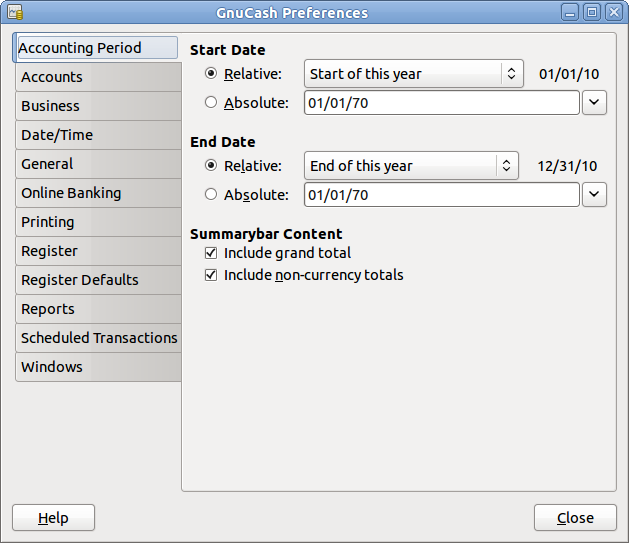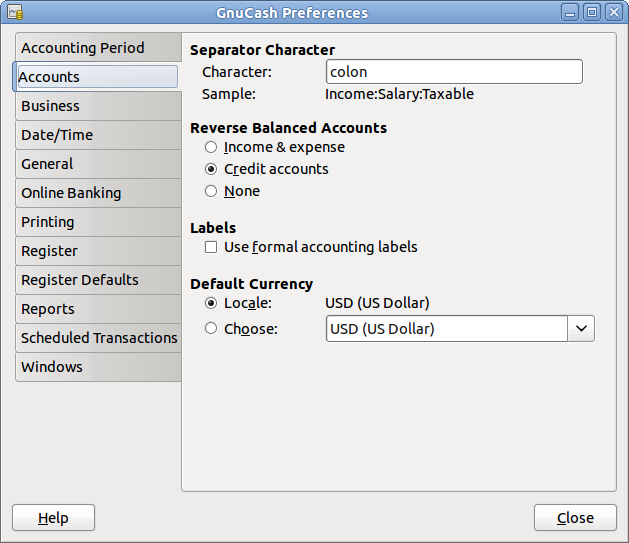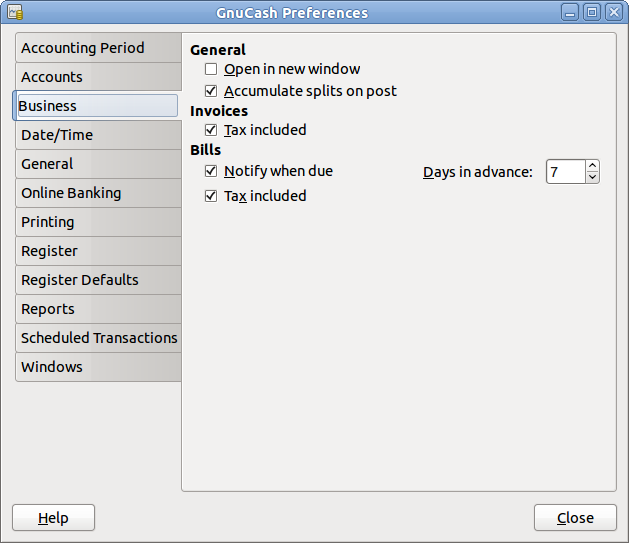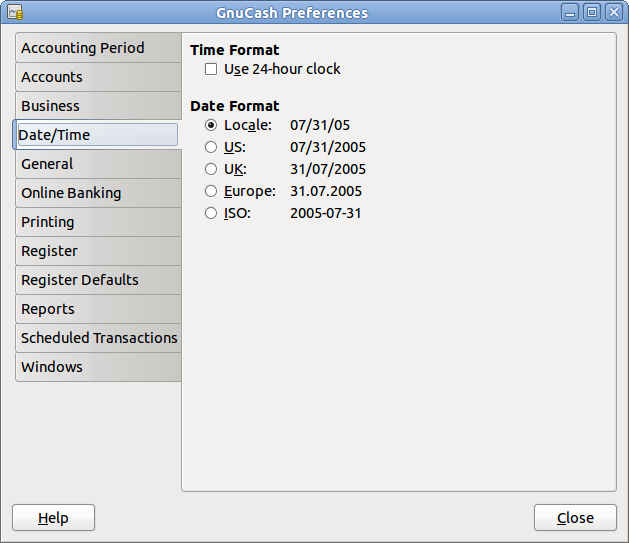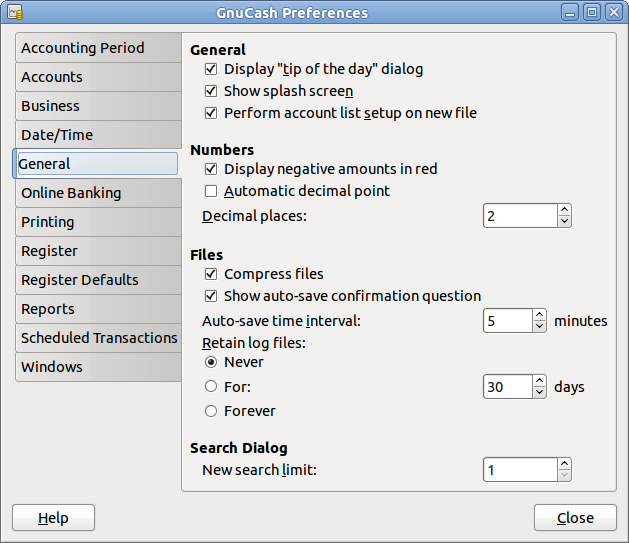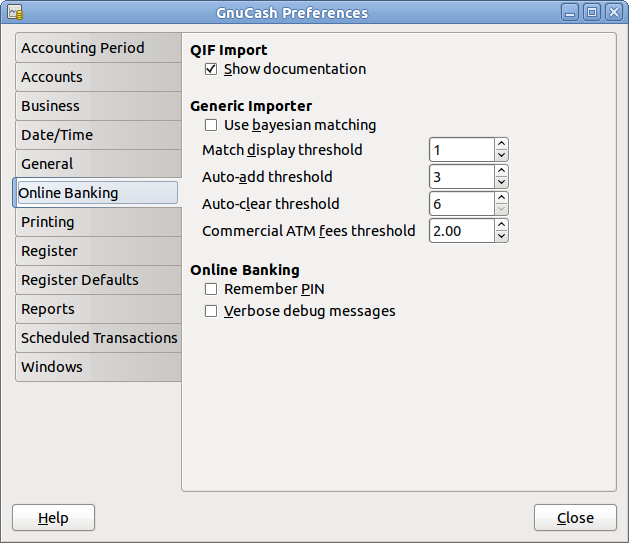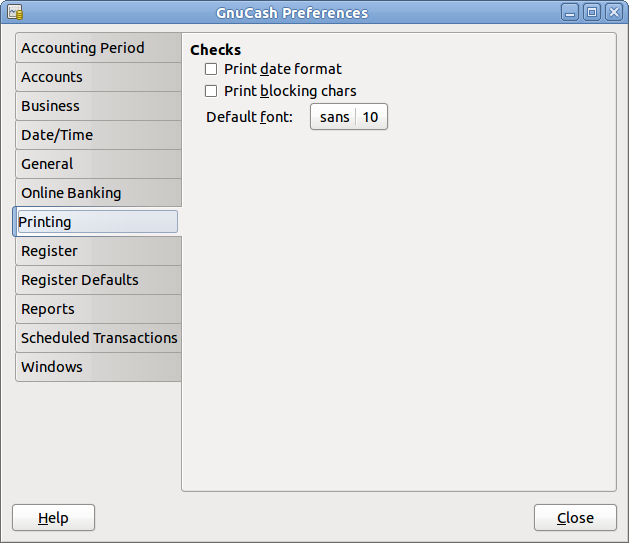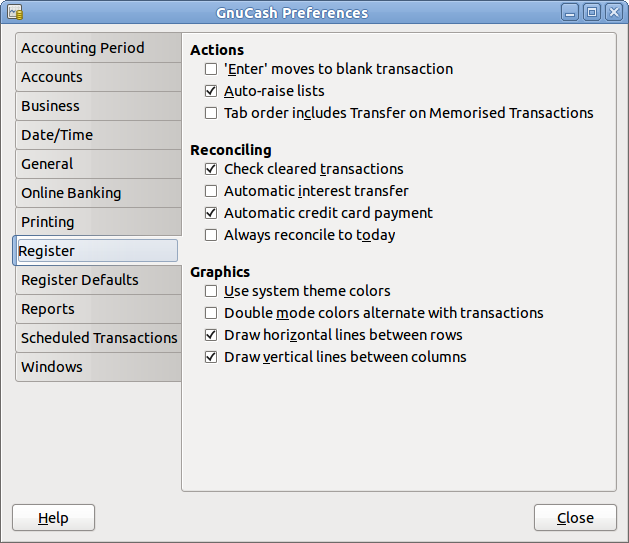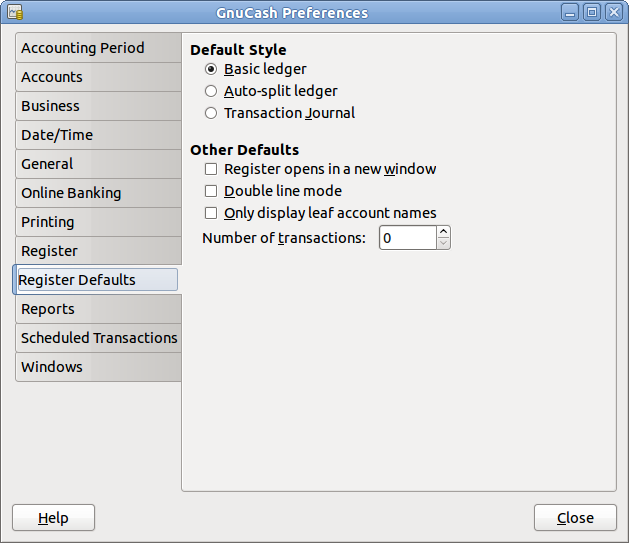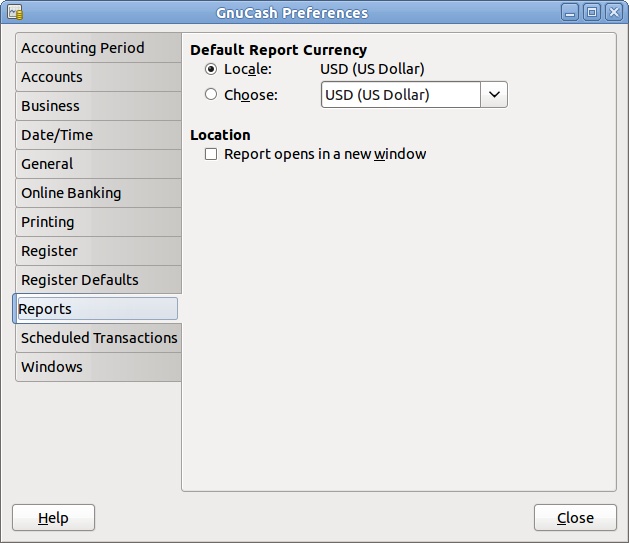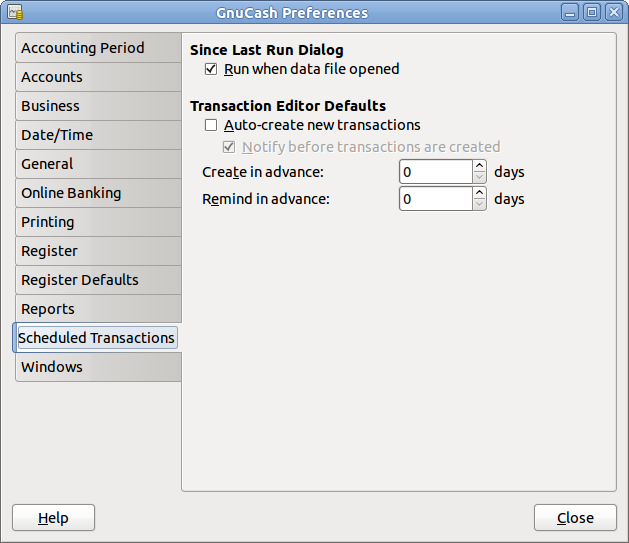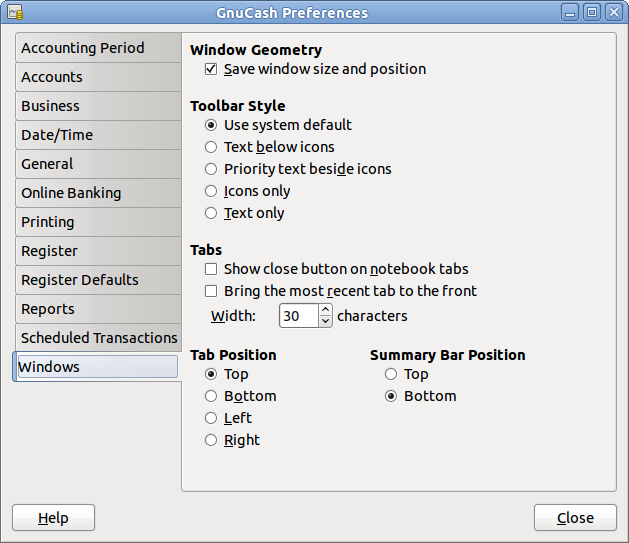The GnuCash Preferences window allows you to customize your GnuCash
session by setting several options. From the GnuCash menu
select →
( → on Mac OS X).
The GnuCash Preferences window will open.
Using the tabs on the left make your desired changes.
 | Tip |
|---|---|
Pausing the cursor for a couple of seconds over options in these windows will display a tooltip with in-depth information on the choice. | |
 | Note |
|---|---|
The changes you made will be applied directly. | |
To close the GnuCash Preferences window press the button.
Each tab in the GnuCash Preferences window is
discussed in its own section below. For a listing of the tabs, see
Chapter 9, Customizing GnuCash.
Start Date — This item sets the accounting period’s start date.
Relative — Use the specified relative starting date for profit/loss calculations. Also use this date for net assets calculations. Relative defines start by today or start of current/previous year, quarter, month.
Absolute — Use the specified absolute starting date for profit/loss calculations. Also use this date for net assets calculations.
End Date — This item sets the accounting period’s end date.
Relative — Use the specified relative ending date for profit/loss calculations. Also use this date for net assets calculations.
Absolute — Use the specified absolute ending date for profit/loss calculations. Also use this date for net assets calculations.
Summarybar content
Include grand total — If checked, show in the Summarybar a grand total of all accounts converted to the default currency.
Include non-currency totals — if this option is selected,
GnuCashwill include in the Summarybar a total for non-currency items (for instance number of shares).
Separator Character — The account separator is the character that separates a parent account from its sub-account, for example Utilities:Electric. The default is a : (Colon), but you can also select / (Slash), \ (Backslash), — (Dash) or . (Period), or any Unicode character that isn’t a letter or a number.
Reverse Balanced accounts — This option lets you determine whether account balances will display as positive or negative numbers:
Income & Expense assigns a positive credit balance to income account balances and a negative debit balance to expense account balances. See Section 5.1, “Types of
GnuCashAccounts” for more information on these account types.Credit accounts (default) displays a positive balance for account types that would normally carry a credit balance (income, credit, liability, equity). See Section 5.1, “Types of
GnuCashAccounts” for more information on these account types.None shows all credit balances as negative and all debit balances as positive.
Labels — Select this option if you want column headings in the register to refer to debits and credits instead of the default informal headings such as withdrawal and deposit.
Default Currency — This item determines which currency will be selected by default when creating new accounts.
Locale — Use the system locale currency for all newly created accounts.
Choose — specify the currency to use, independent of your system settings.
General
Open in new window — If checked, each invoice will be opened in its own top level window. If clear, the invoice will be opened in the current window.
Accumulate splits on post — Whether multiple entries in an invoice which transfer to the same account should be accumulated into a single split by default.
Invoices
Tax Included — Whether tax are included by default in entries on invoices. This setting is inherited by new customers and vendors.
Bills
Notify when due — Lets you set whether you want to be notified at
GnuCashstartup of when a bill is soon to be due.Days in advance — How many days before the due date to warn about bills coming due.
Tax Included — Whether tax are included by default in entries on bills. This setting is inherited by new customers and vendors.
Time Format
Use 24-hour clock — Lets you specify if you want to use 24 or 12 hours time format. That is if 11 o’clock at night should be represented as 11PM or 23:00.
Date Format — This option controls the appearance of the date (you could see a preview of the date beside any of the choices). The available choices are:
Locale — Use the date format specified by the system locale.
US — Use the date format common in the United States.
UK — Use the date format common in the United Kingdom.
Europe — Use the date format common in continental Europe.
ISO — Use the date format specified by the ISO-8601 standard.
General
Display "Tip of the Day" dialog — This option displays or hides the Tip of the Day screen when
GnuCashis started.Show splash screen — With this option you can enable or disable the visualization of the startup screen while
GnuCashis starting up.Perform account list setup on new file — This option turns off the display of the New Account Hierarchy Setup assistant when the entry → is selected from the
GnuCashmenu.
Numbers
Display negative amounts in red — If you turn off this option,
GnuCashwill display negative numbers in black.Automatic Decimal Point — This option will automatically insert a decimal point into numbers you type in.
Decimal Places — This field allows you to set the number of decimal places to be used.
Files

Note The following options are only relevant for files saved in XML format.
Compress files — This option determines whether the
GnuCashdata file will be compressed or not.Show auto-save confirmation question — If this option is enabled,
GnuCashwill show you a confirmation screen each time the auto-save process is started.Auto-save time interval — This field sets the number of minutes between each automatic saving of the file. Set to 0 to disable the auto-save feature.
Retain log files — In this section you could set your preferences about the log files using the provided radio buttons.
Never — Disable the creation of log files.
For: — Enter a specific number of days for which keep the files.
Forever — Disable the auto deletion of log files; retains the log files forever.
Search Dialog
New search limit: — Defaults to "new search" if fewer than this number of items is returned.
QIF Import
Show documentation — The first time you use the QIF importer you may notice that the importer has detailed instructions on how to import a file. Once you have become familiar with using the importer, you might want to turn off this option. Turning off the option gives you less detail in the importer screens.
Generic Importer
Use Bayesian matching — Use Bayesian algorithms to match new transactions with existing accounts.
Match display threshold — The minimal score a potential match must have to be displayed in the match list.
Auto-add threshold — A transaction whose best match’s score is in the red zone (above display threshold, but below or equal to Auto-add threshold) will be added by default.
Auto-clear threshold — A transaction whose best match’s score is in the green zone (above or equal to Auto-clear threshold) will be cleared by default.
Commercial ATM fees threshold — In some places commercial ATMs (not belonging to a financial institution) are installed in places like convenience store. These ATM add its fee directly to the amount instead of showing up as a separate transaction or in your monthly banking fees. For example, you withdraw $100, and you are charged $101.50 plus Interac fees. If you manually entered that $100, the amounts won’t match. You should set this to whatever is the maximum such fee in your area (in units of your local currency), so the transaction will be recognized as a match by
GnuCash.
Online Banking

Note This section is showed only if
GnuCashis compiled with Aqbanking and HBCI support.Remember PIN — Enable this option if you want
GnuCashto remember the PIN you enter for online banking authentication.Verbose debug messages — Enable this option if you want
GnuCashto show more information about the online banking operations.
The Printing tab allows you to set some options that affect the printing on paper of checks.
Print date format — Enable this option if you want to print on the check, below the actual date, its format in 8 point type.
Print blocking chars — Enable this option to print a series of three asterisks before and after each text field in the check.
Default font: — Click the button on the left to open a Pick a Font screen in which you can customize the font that will be used to print checks.
Actions
'Enter' moves to blank transaction — If selected, move the cursor to the blank transaction at the end of the register after the user presses the Enter key. Otherwise the cursor will be moved down one row.
Auto-raise lists — If selected, all lists will automatically be expanded when input focus is in the list field.
Tab order includes Transfer on Memorised Transaction — If selected, when the transaction is auto filled, pressing the Tab key in the register the cursor’s jump will include the Transfer field.
Reconciling
Check cleared transactions — If selected, automatically check off cleared transactions when reconciling.
Automatic interest transfer — If selected, prior to reconciling an account which charges or pays interest, prompt the user to enter a transaction for the interest charge or payment. Currently only enabled for Bank, Credit, Mutual, Asset, Receivable, Payable, and Liability accounts.
Automatic credit card payment — If selected, after reconciling a credit card statement, prompt the user to enter a credit card payment.
Always reconcile to today — If selected, always open the reconcile screen with today’s date for statement date, regardless of previous reconciliation.
Graphics
Use system theme colors — If selected, the system color theme will be applied to register windows. Otherwise the original
GnuCashregister color will be used.Double mode colors alternate with transactions — If selected, configures the register window to alternate between the primary and secondary colors with each transaction, instead of each row.
Draw horizontal lines between rows — If selected,
GnuCashwill draw a horizontal line between each row.Draw vertical lines between columns — If selected,
GnuCashwill draw a vertical line between the cells in each row.
The Register Defaults tab preferences affect the behavior of the transaction register windows.
Default Style
Here you can choose from 3 different styles for register windows:
Basic ledger — Show all transactions on one line. (Two in double line mode.)
Auto-split ledger — Automatically expand the current transaction to show all splits. All other transactions are shown on one line. (Two in double line mode.)
Transaction journal — All transactions are expanded to show all splits.
Other Defaults
Register opens in a new window — If selected, register will be in a separate window instead of in a tab.
Double line mode — If selected, show two lines of information for each transaction instead of one.
Only display leaf account names — If selected, only the name of the leaf accounts will be displayed in the Account selection popup. The default behavoir is to display the full account name including the path in the account tree.

Warning Enabling this option implies that you use unique leaf account names.
Number of transactions — How many transactions to show in a register. Set to 0 to show all transactions.
The Reports tab preferences affect
the behavior of GnuCash
reports.
Default Report Currency — This item determines which currency will be used by default when creating reports. You can choose:
Locale — Use the system locale currency for all newly created reports.
Choose — Use the specified currency for all newly created reports.
Location
Report opens in a new window — if you select this option, the reports will open up in a new window, instead of in a tab.
The Scheduled Transactions tab
preferences affect the behavior of
GnuCash for scheduling transactions.
More information about scheduled transactions can be found in
Section 6.12, “Scheduling Transactions”.
Since Last Run Dialog
Run when data file opened — If selected, the Since Last Run screen will appear on
GnuCashstart-up (or rather whenGnuCashopens the file).
Transaction Editor Defaults
Auto-Create new transactions — If selected, new scheduled transactions will automatically be entered into the register. If the auto-create option is enabled, you could also check Notify before transactions are created so that you will be able to confirm creating the transactions.
Create in advance, days — The default number of days in advance to create the registered scheduled transactions.
Remind in advance, days — The default number of days in advance to remind on new scheduled transactions.
Window Geometry
Save window size and position — If selected, next time
GnuCashstarts will re-use the windows size and position configured in the last run.
Toolbar style
You can choose from five different styles for the Toolbar:
Use system default (default) — Use the system setting for displaying Toolbar items.
Text below icons — Display Toolbar items with the text label below the icon. Labels are shown for all items.
Priority text beside icons — Display Toolbar items with the text label beside the icon. Labels are only shown for the most important items.
Icons only — Display Toolbar items as icons only.
Text only — Display Toolbar items as text only.
Tabs
Show close button on notebook tabs — Adds a small close icon on each tab, to make it easier to close the various tabs.
Bring the most recent tab to the front — If selected, the newly created tab will be shown over the other tabs.
Width: — The width of tab label expressed in characters.
Tab Position
Position the tabs at the Top (default), Bottom, Left or Right.
Summary Bar Position
Position the Summary Bar at the Top or at the Bottom (default) of the
GnuCashmain window.
